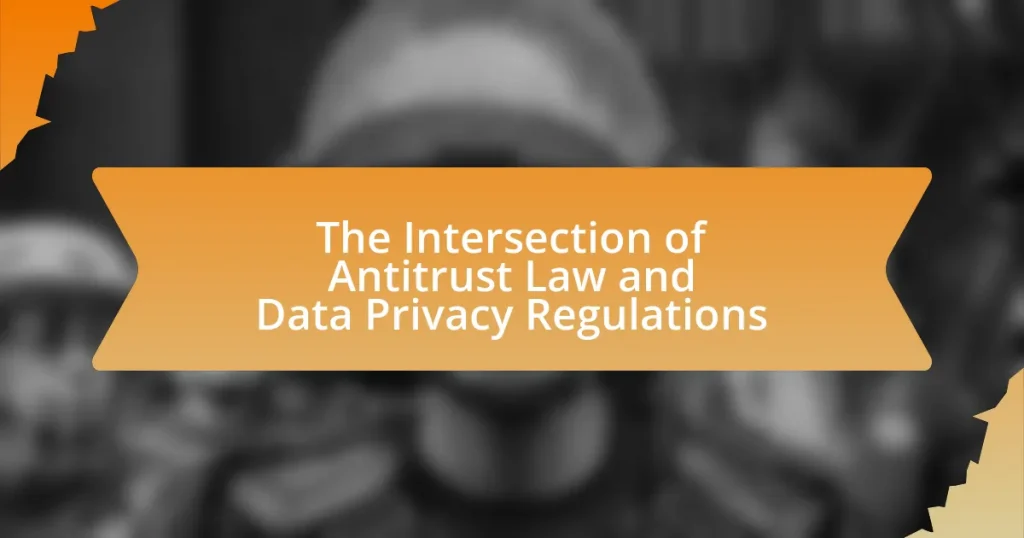The article focuses on emerging trends in antitrust enforcement following the COVID-19 pandemic, highlighting increased scrutiny of digital markets, labor market competition, and enhanced international regulatory collaboration. It discusses how the pandemic has influenced enforcement practices, leading to a more proactive approach in sectors like healthcare and technology, where mergers and acquisitions are closely monitored. Key challenges faced by enforcement agencies include adapting to digital transformation, resource constraints, and the complexities of international cooperation. The article also outlines strategies for businesses to navigate the evolving antitrust landscape, emphasizing the importance of compliance and corporate governance in mitigating risks associated with anti-competitive practices.

What are the Emerging Trends in Antitrust Enforcement Post-COVID-19?
Emerging trends in antitrust enforcement post-COVID-19 include increased scrutiny of digital markets, a focus on labor market competition, and heightened collaboration among international regulatory bodies. Regulatory agencies, such as the Federal Trade Commission and the European Commission, have intensified their examination of tech giants, citing concerns over monopolistic practices and data privacy. For instance, the U.S. Department of Justice has pursued cases against major technology firms, reflecting a shift towards more aggressive enforcement strategies. Additionally, there is a growing emphasis on protecting workers’ rights and preventing anti-competitive practices that suppress wages, as seen in recent investigations into labor market concentration. This trend is supported by the recognition that economic recovery post-pandemic requires fair competition across all sectors.
How has the COVID-19 pandemic influenced antitrust enforcement practices?
The COVID-19 pandemic has significantly influenced antitrust enforcement practices by prompting regulators to adapt their approaches to address emerging market dynamics and consumer protection issues. For instance, the pandemic led to increased scrutiny of mergers and acquisitions in sectors heavily impacted by COVID-19, such as healthcare and technology, as authorities aimed to prevent anti-competitive behavior that could arise from market consolidation during a crisis. Additionally, the Federal Trade Commission and the Department of Justice in the United States have emphasized the importance of maintaining competition in essential goods and services, leading to more proactive investigations into price gouging and supply chain disruptions. This shift reflects a broader trend towards a more flexible and responsive antitrust framework that prioritizes consumer welfare and market stability in the face of unprecedented challenges.
What specific changes in enforcement priorities have emerged since the pandemic?
Since the pandemic, enforcement priorities have shifted towards addressing anti-competitive behaviors that emerged during the crisis, particularly in digital markets and essential goods. Regulatory agencies, such as the Federal Trade Commission and the Department of Justice in the United States, have increased scrutiny on mergers and acquisitions that could harm competition, especially in sectors like healthcare and technology. For instance, the FTC has actively challenged several proposed mergers that could consolidate market power in the pharmaceutical industry, reflecting a heightened focus on consumer welfare and market fairness in the wake of pandemic-related disruptions.
How have enforcement agencies adapted their strategies in response to COVID-19?
Enforcement agencies have adapted their strategies in response to COVID-19 by increasing the use of digital tools and remote monitoring to ensure compliance with regulations. For instance, many agencies have shifted to virtual investigations and online hearings, allowing them to maintain oversight while adhering to social distancing measures. This transition has been supported by the rapid adoption of technology, which has enabled agencies to analyze data more efficiently and respond to emerging antitrust issues related to the pandemic, such as price gouging and supply chain disruptions. Additionally, agencies have focused on collaboration with other regulatory bodies to address cross-border challenges that arose during the crisis, enhancing their ability to enforce antitrust laws effectively in a rapidly changing environment.
What role does digital transformation play in antitrust enforcement trends?
Digital transformation significantly influences antitrust enforcement trends by reshaping market dynamics and competitive behaviors. As businesses increasingly adopt digital technologies, regulators are adapting their approaches to address new forms of market power and anti-competitive practices that arise in digital ecosystems. For instance, the rise of data-driven business models has prompted antitrust authorities to scrutinize mergers and acquisitions more closely, particularly in technology sectors where data control can lead to monopolistic behaviors. The European Commission’s Digital Markets Act exemplifies this shift, aiming to ensure fair competition in digital markets by imposing stricter regulations on major tech companies. This evolving landscape necessitates that antitrust enforcement agencies develop new frameworks and tools to effectively monitor and regulate digital markets, reflecting the profound impact of digital transformation on competition law.
How has the increase in digital commerce affected antitrust scrutiny?
The increase in digital commerce has intensified antitrust scrutiny as regulators seek to address market dominance and anti-competitive practices in the online space. This heightened focus is driven by the rapid growth of major digital platforms, which have raised concerns about monopolistic behaviors and their impact on competition. For instance, the U.S. Department of Justice and the Federal Trade Commission have initiated investigations and lawsuits against companies like Google and Facebook, citing their control over digital advertising and social media markets as potential violations of antitrust laws. Additionally, the European Union has implemented stricter regulations, such as the Digital Markets Act, aimed at ensuring fair competition among digital service providers. These actions reflect a broader trend of regulatory bodies adapting to the challenges posed by the digital economy, emphasizing the need for updated frameworks to effectively manage competition in this evolving landscape.
What are the implications of data privacy concerns on antitrust enforcement?
Data privacy concerns significantly impact antitrust enforcement by necessitating a more integrated approach to regulation that considers both competition and consumer protection. As companies increasingly collect and utilize personal data, regulators face challenges in balancing market competition with the need to protect consumer privacy. For instance, the European Union’s General Data Protection Regulation (GDPR) has influenced antitrust investigations by emphasizing the importance of data handling practices, leading to scrutiny of mergers and acquisitions that could reduce competition while compromising user privacy. This dual focus on data privacy and competition reflects a growing recognition that data control can create market power, thereby shaping the landscape of antitrust enforcement in a post-COVID-19 environment.
What are the key sectors experiencing heightened antitrust scrutiny post-COVID-19?
The key sectors experiencing heightened antitrust scrutiny post-COVID-19 include technology, healthcare, and agriculture. The technology sector faces increased examination due to concerns over market dominance by major firms like Google and Amazon, which have been scrutinized for anti-competitive practices. In healthcare, the pandemic highlighted issues related to mergers and acquisitions that could reduce competition and raise prices, prompting regulators to closely monitor pharmaceutical companies and hospital systems. The agriculture sector is under scrutiny as well, particularly regarding consolidation among suppliers and distributors, which may limit competition and affect food prices. These trends reflect a broader regulatory focus on maintaining competitive markets in the wake of the pandemic’s economic impacts.
Which industries are most impacted by new antitrust regulations?
The technology and telecommunications industries are most impacted by new antitrust regulations. These sectors face increased scrutiny due to concerns over monopolistic practices and market dominance, particularly among major players like Google, Amazon, and Facebook. For instance, the European Union’s Digital Markets Act aims to curb anti-competitive behavior in these industries, reflecting a global trend towards stricter enforcement of antitrust laws. Additionally, the healthcare industry is also significantly affected, as regulators focus on mergers and acquisitions that could reduce competition and raise prices for consumers.
How are mergers and acquisitions being evaluated differently in the current climate?
Mergers and acquisitions are being evaluated differently in the current climate due to heightened scrutiny from regulatory bodies and a shift in focus towards long-term sustainability and market impact. Regulatory agencies, influenced by the economic disruptions caused by COVID-19, are increasingly concerned about the potential for reduced competition and market monopolization, leading to more rigorous antitrust reviews. For instance, the Federal Trade Commission has intensified its examination of mergers that could harm consumer welfare or stifle innovation, reflecting a broader trend towards protecting market dynamics rather than merely assessing financial metrics. This shift is evidenced by the increase in blocked or challenged mergers in sectors like technology and healthcare, where the implications for competition are deemed significant.

What are the Challenges Faced in Antitrust Enforcement Post-COVID-19?
Antitrust enforcement post-COVID-19 faces several challenges, including increased market concentration, the rise of digital platforms, and evolving consumer behavior. Increased market concentration has been observed as many businesses merged or acquired during the pandemic, leading to fewer competitors in various sectors. The dominance of digital platforms has complicated enforcement, as traditional antitrust frameworks struggle to address the unique characteristics of online markets. Additionally, shifting consumer behavior, driven by the pandemic, has altered market dynamics, making it difficult for regulators to assess competitive practices accurately. These challenges necessitate a reevaluation of antitrust strategies to effectively address the new economic landscape.
What obstacles do enforcement agencies encounter in adapting to new trends?
Enforcement agencies encounter several obstacles in adapting to new trends, including technological challenges, resource limitations, and evolving legal frameworks. Technological challenges arise as agencies struggle to keep pace with rapid advancements in digital markets and data analytics, which complicate the detection and prosecution of antitrust violations. Resource limitations, such as insufficient funding and personnel, hinder agencies’ ability to effectively investigate and enforce new regulations. Additionally, evolving legal frameworks create uncertainty, as agencies must navigate complex and often ambiguous laws that may not adequately address contemporary market dynamics. These factors collectively impede the ability of enforcement agencies to respond effectively to emerging trends in antitrust enforcement.
How do resource constraints affect antitrust investigations?
Resource constraints significantly hinder antitrust investigations by limiting the capacity of regulatory bodies to conduct thorough analyses and enforce compliance. For instance, when agencies face budget cuts or staffing shortages, they may prioritize cases based on perceived severity, potentially overlooking smaller but equally harmful anti-competitive practices. A study by the Government Accountability Office in 2020 highlighted that the Federal Trade Commission’s budget constraints led to a reduction in the number of investigations initiated, which directly impacts the effectiveness of antitrust enforcement. Consequently, resource limitations can result in slower response times to anti-competitive behavior and a decreased deterrent effect on potential violators.
What challenges arise from international cooperation in antitrust cases?
International cooperation in antitrust cases faces several challenges, primarily due to differing legal frameworks and enforcement priorities among countries. These differences can lead to conflicts in jurisdiction, where one country may pursue an antitrust action that another country views as unnecessary or harmful. Additionally, variations in the definition of anti-competitive behavior complicate collaborative efforts, as countries may not agree on what constitutes a violation.
For instance, the European Union has stricter regulations on market dominance compared to the United States, which can create friction in cases involving multinational corporations. Furthermore, language barriers and cultural differences can hinder effective communication and coordination among international regulatory bodies. These challenges are exacerbated by the lack of a unified global antitrust authority, which makes it difficult to streamline processes and share information efficiently.
How do businesses navigate the evolving antitrust landscape?
Businesses navigate the evolving antitrust landscape by actively monitoring regulatory changes and adapting their compliance strategies accordingly. They engage in regular assessments of their market practices to ensure alignment with new antitrust laws and guidelines, which have become more stringent post-COVID-19. For instance, the Federal Trade Commission and the Department of Justice have increased scrutiny on mergers and acquisitions, prompting companies to conduct thorough due diligence and seek legal counsel to mitigate risks. Additionally, businesses are investing in training programs to educate employees about antitrust compliance, thereby fostering a culture of adherence to legal standards. This proactive approach is essential as the antitrust environment continues to evolve, reflecting a heightened focus on competition and consumer protection.
What strategies can companies employ to ensure compliance with new regulations?
Companies can employ several strategies to ensure compliance with new regulations, including establishing a robust compliance program, conducting regular training, and engaging in proactive risk assessments. A robust compliance program involves creating clear policies and procedures that align with regulatory requirements, which helps mitigate risks associated with non-compliance. Regular training ensures that employees are informed about the latest regulations and understand their responsibilities, thereby fostering a culture of compliance within the organization. Proactive risk assessments allow companies to identify potential compliance gaps and address them before they lead to violations. According to a study by the Association of Certified Fraud Examiners, organizations with effective compliance programs can reduce the risk of regulatory violations by up to 50%.
How can businesses prepare for potential antitrust investigations?
Businesses can prepare for potential antitrust investigations by conducting thorough internal audits of their practices and compliance with antitrust laws. This proactive approach involves reviewing pricing strategies, market share, and competitive practices to ensure they align with legal standards. For instance, the Federal Trade Commission (FTC) has increased scrutiny on mergers and acquisitions, emphasizing the importance of transparency and fair competition. By implementing robust compliance programs and training employees on antitrust regulations, businesses can mitigate risks and demonstrate their commitment to lawful practices.

What Future Directions Can We Expect in Antitrust Enforcement?
Future directions in antitrust enforcement will likely focus on increased scrutiny of digital markets and the behavior of large technology companies. Regulatory bodies, such as the Federal Trade Commission and the Department of Justice in the United States, are emphasizing the need for more rigorous investigations into anti-competitive practices, particularly in the tech sector, where market dominance can stifle competition. For instance, the rise of platforms like Amazon and Google has prompted calls for reforms that address monopolistic behaviors and promote fair competition. Additionally, there is a growing trend towards international cooperation among antitrust authorities to tackle cross-border anti-competitive practices, as evidenced by recent collaborations between the European Union and U.S. regulators. These developments indicate a shift towards a more proactive and comprehensive approach to antitrust enforcement in response to evolving market dynamics.
How might antitrust enforcement evolve in the next few years?
Antitrust enforcement is likely to evolve towards increased scrutiny of digital markets and greater emphasis on consumer welfare in the next few years. Regulatory bodies, such as the Federal Trade Commission and the European Commission, are focusing on the monopolistic practices of major tech companies, as evidenced by recent high-profile cases against firms like Google and Facebook. Additionally, there is a growing trend towards adopting more aggressive merger review processes, as seen in the Biden administration’s push for stricter antitrust policies. This shift is supported by a broader public sentiment favoring competition and innovation, which has been amplified by the economic disruptions caused by the COVID-19 pandemic.
What trends are likely to shape future antitrust policies?
Future antitrust policies are likely to be shaped by increased scrutiny of digital markets, a focus on consumer welfare, and the integration of sustainability considerations. The rise of technology giants has prompted regulators to examine market dominance and anti-competitive practices more closely, as evidenced by recent actions against companies like Google and Facebook. Additionally, the consumer welfare standard remains a cornerstone of antitrust analysis, emphasizing the importance of protecting consumer interests in pricing and choice. Furthermore, there is a growing recognition of the need to incorporate environmental sustainability into antitrust assessments, reflecting societal shifts towards greener practices. These trends indicate a more dynamic and multifaceted approach to antitrust enforcement in the post-COVID-19 landscape.
How will technological advancements influence antitrust enforcement?
Technological advancements will significantly influence antitrust enforcement by enabling more sophisticated data analysis and monitoring of market behaviors. These advancements allow regulatory bodies to better identify anti-competitive practices through enhanced algorithms and machine learning techniques that can analyze large datasets for patterns indicative of monopolistic behavior. For instance, the use of big data analytics can help regulators assess market dominance and consumer harm more effectively, as seen in the European Commission’s investigations into tech giants like Google and Amazon, where data-driven insights played a crucial role in decision-making. Additionally, technology facilitates real-time monitoring of market dynamics, enabling quicker responses to potential anti-competitive actions, thereby improving the overall efficacy of antitrust enforcement.
What best practices should businesses adopt in light of emerging trends?
Businesses should adopt proactive compliance strategies, focusing on transparency and collaboration with regulatory authorities in light of emerging trends in antitrust enforcement post-COVID-19. This approach is essential as regulatory scrutiny has intensified, with agencies like the Federal Trade Commission and the Department of Justice increasing their focus on anti-competitive practices. For instance, in 2021, the Biden administration emphasized a more aggressive stance on antitrust issues, leading to a surge in investigations and lawsuits against major corporations. By implementing robust compliance programs, conducting regular audits, and fostering open communication with regulators, businesses can mitigate risks and align with evolving legal expectations.
How can companies proactively address antitrust risks?
Companies can proactively address antitrust risks by implementing robust compliance programs that include regular training, monitoring, and audits. These programs should be designed to educate employees about antitrust laws and the potential consequences of non-compliance, thereby fostering a culture of compliance within the organization. For instance, a study by the American Bar Association indicates that companies with effective compliance programs are less likely to face antitrust investigations. Additionally, companies should conduct regular risk assessments to identify and mitigate potential antitrust issues in their business practices, ensuring they adapt to evolving regulatory landscapes, especially in the post-COVID-19 environment where enforcement has intensified.
What role does corporate governance play in ensuring compliance?
Corporate governance plays a critical role in ensuring compliance by establishing frameworks and processes that promote accountability, transparency, and ethical behavior within organizations. Effective corporate governance structures, such as boards of directors and compliance committees, are responsible for overseeing adherence to laws and regulations, thereby reducing the risk of non-compliance. For instance, companies with robust governance practices are more likely to implement comprehensive compliance programs that align with regulatory requirements, as evidenced by the increased scrutiny and enforcement actions observed in the wake of the COVID-19 pandemic. This heightened focus on compliance has led organizations to prioritize governance mechanisms that facilitate ongoing monitoring and reporting, ultimately fostering a culture of compliance that mitigates legal and financial risks.



